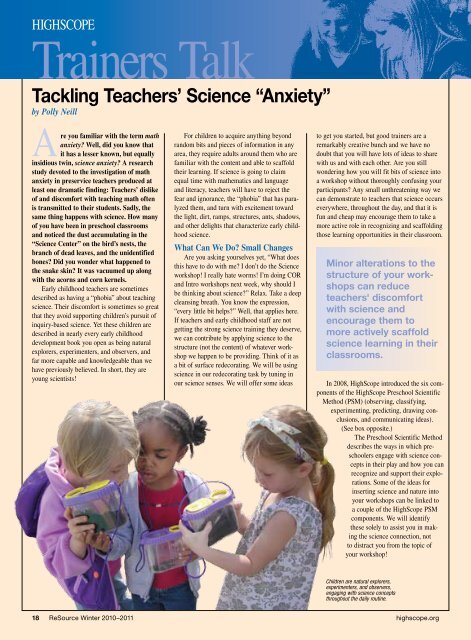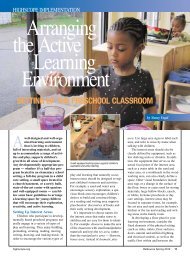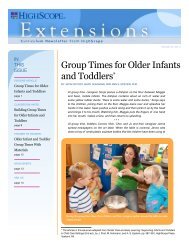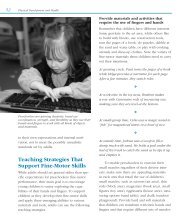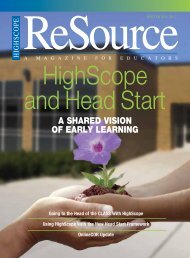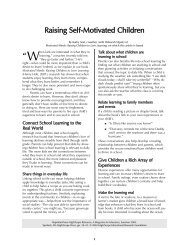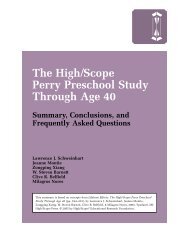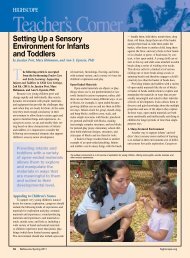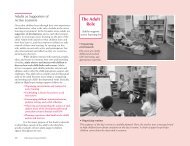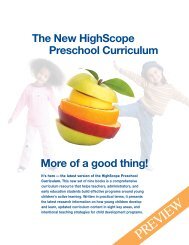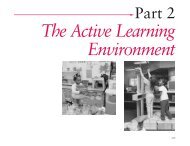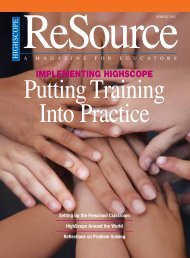DIVERSE AND INCLUSIVE CLASSROOM - High/Scope Educational ...
DIVERSE AND INCLUSIVE CLASSROOM - High/Scope Educational ...
DIVERSE AND INCLUSIVE CLASSROOM - High/Scope Educational ...
You also want an ePaper? Increase the reach of your titles
YUMPU automatically turns print PDFs into web optimized ePapers that Google loves.
HIgHSCOPE<br />
Trainers Talk<br />
Tackling Teachers’ Science “Anxiety”<br />
by Polly Neill<br />
A<br />
re you familiar with the term math<br />
anxiety? Well, did you know that<br />
it has a lesser known, but equally<br />
insidious twin, science anxiety? A research<br />
study devoted to the investigation of math<br />
anxiety in preservice teachers produced at<br />
least one dramatic finding: Teachers’ dislike<br />
of and discomfort with teaching math often<br />
is transmitted to their students. Sadly, the<br />
same thing happens with science. How many<br />
of you have been in preschool classrooms<br />
and noticed the dust accumulating in the<br />
“Science Center” on the bird’s nests, the<br />
branch of dead leaves, and the unidentified<br />
bones? Did you wonder what happened to<br />
the snake skin? It was vacuumed up along<br />
with the acorns and corn kernels.<br />
Early childhood teachers are sometimes<br />
described as having a “phobia” about teaching<br />
science. Their discomfort is sometimes so great<br />
that they avoid supporting children’s pursuit of<br />
inquiry-based science. Yet these children are<br />
described in nearly every early childhood<br />
development book you open as being natural<br />
explorers, experimenters, and observers, and<br />
far more capable and knowledgeable than we<br />
have previously believed. In short, they are<br />
young scientists!<br />
for children to acquire anything beyond<br />
random bits and pieces of information in any<br />
area, they require adults around them who are<br />
familiar with the content and able to scaffold<br />
their learning. If science is going to claim<br />
equal time with mathematics and language<br />
and literacy, teachers will have to reject the<br />
fear and ignorance, the “phobia” that has paralyzed<br />
them, and turn with excitement toward<br />
the light, dirt, ramps, structures, ants, shadows,<br />
and other delights that characterize early childhood<br />
science.<br />
What Can We Do? Small Changes<br />
Are you asking yourselves yet, “What does<br />
this have to do with me? I don’t do the Science<br />
workshop! I really hate worms! I’m doing COR<br />
and Intro workshops next week, why should I<br />
be thinking about science?” Relax. Take a deep<br />
cleansing breath. You know the expression,<br />
“every little bit helps?” Well, that applies here.<br />
If teachers and early childhood staff are not<br />
getting the strong science training they deserve,<br />
we can contribute by applying science to the<br />
structure (not the content) of whatever workshop<br />
we happen to be providing. Think of it as<br />
a bit of surface redecorating. We will be using<br />
science in our redecorating task by tuning in<br />
our science senses. We will offer some ideas<br />
to get you started, but good trainers are a<br />
remarkably creative bunch and we have no<br />
doubt that you will have lots of ideas to share<br />
with us and with each other. Are you still<br />
wondering how you will fit bits of science into<br />
a workshop without thoroughly confusing your<br />
participants? Any small unthreatening way we<br />
can demonstrate to teachers that science occurs<br />
everywhere, throughout the day, and that it is<br />
fun and cheap may encourage them to take a<br />
more active role in recognizing and scaffolding<br />
those learning opportunities in their classroom.<br />
Minor alterations to the<br />
structure of your workshops<br />
can reduce<br />
teachers' discomfort<br />
with science and<br />
encourage them to<br />
more actively scaffold<br />
science learning in their<br />
classrooms.<br />
In 2008, <strong>High</strong><strong>Scope</strong> introduced the six components<br />
of the <strong>High</strong><strong>Scope</strong> Preschool Scientific<br />
method (PSm) (observing, classifying,<br />
experimenting, predicting, drawing conclusions,<br />
and communicating ideas).<br />
(See box opposite.)<br />
The Preschool Scientific method<br />
describes the ways in which preschoolers<br />
engage with science concepts<br />
in their play and how you can<br />
recognize and support their explorations.<br />
Some of the ideas for<br />
inserting science and nature into<br />
your workshops can be linked to<br />
a couple of the <strong>High</strong><strong>Scope</strong> PSm<br />
components. We will identify<br />
these solely to assist you in making<br />
the science connection, not<br />
to distract you from the topic of<br />
your workshop!<br />
Children are natural explorers,<br />
experimenters, and observers,<br />
engaging with science concepts<br />
throughout the daily routine.<br />
18 ReSource Winter 2010–2011 highscope.org


